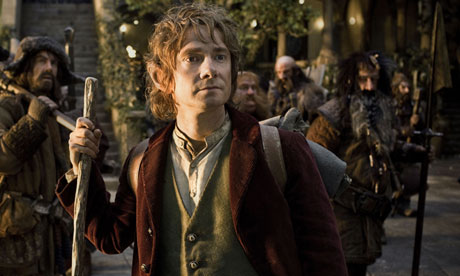
The Hobbit may have been the result of JRR Tolkien's fascination with the a real-life cursed ring story. Photograph: New Line Cinema/Sportsphoto Ltd./Allstar
In what was once the housekeeper's office of a Tudor mansion in Hampshire, a very odd golden ring glitters on a revolving stand in a tall perspex column. In chapter five of The Hobbit, Bilbo Baggins finds a ring in the gloom of Gollum's cave. Not just any ring. "One very beautiful thing, very beautiful, very wonderful. He had a ring, a golden ring, a precious ring."
A new exhibition opening today at The Vyne, now owned by the National Trust, raises the intriguing possibility that the Roman ring in the case, and the ring of power in JRR Tolkien's book The Hobbit, and in his Lord of the Rings trilogy, are one and the same.
As Dave Green, the property manager, explains, there's more to the story than the ring – an iron-age site with ancient mine workings known as "the Dwarf's Hill", a curse on the thief who stole the ring, and a strong link to Tolkien himself.
Tolkien was a professor of Anglo-Saxon at Oxford before he found fame as an author, with the publication of The Hobbit in 1937, and the first of the Rings trilogy in 1954. He certainly knew the story of the curse and the ring, and was researching the subject two years before he began work on The Hobbit.
The ring was in the collection of the Chute family – which for generations was interested in politics, collecting, and antiquarian research – for centuries before the house came to the National Trust in the 1930s.
"I was looking for the ring to show a visitor, and I walked right past the case with it – that's when I decided we really had to make more of this amazing thing," Green said. As well as the exhibition room, created with the help of the Tolkien Trust, the house now has a dwarf trail for children and a new playground with circular tunnels and green hillocks recalling Bilbo's home, Bag End.
The ring was probably found in 1785 by a farmer ploughing a few miles away within the walls of Silchester, one of the most enigmatic Roman sites in the country – a town which flourished before the Roman invasion, was abandoned by the 7th century and was never reoccupied.
More
A new exhibition opening today at The Vyne, now owned by the National Trust, raises the intriguing possibility that the Roman ring in the case, and the ring of power in JRR Tolkien's book The Hobbit, and in his Lord of the Rings trilogy, are one and the same.
As Dave Green, the property manager, explains, there's more to the story than the ring – an iron-age site with ancient mine workings known as "the Dwarf's Hill", a curse on the thief who stole the ring, and a strong link to Tolkien himself.
Tolkien was a professor of Anglo-Saxon at Oxford before he found fame as an author, with the publication of The Hobbit in 1937, and the first of the Rings trilogy in 1954. He certainly knew the story of the curse and the ring, and was researching the subject two years before he began work on The Hobbit.
The ring was in the collection of the Chute family – which for generations was interested in politics, collecting, and antiquarian research – for centuries before the house came to the National Trust in the 1930s.
"I was looking for the ring to show a visitor, and I walked right past the case with it – that's when I decided we really had to make more of this amazing thing," Green said. As well as the exhibition room, created with the help of the Tolkien Trust, the house now has a dwarf trail for children and a new playground with circular tunnels and green hillocks recalling Bilbo's home, Bag End.
The ring was probably found in 1785 by a farmer ploughing a few miles away within the walls of Silchester, one of the most enigmatic Roman sites in the country – a town which flourished before the Roman invasion, was abandoned by the 7th century and was never reoccupied.
More
No comments:
Post a Comment